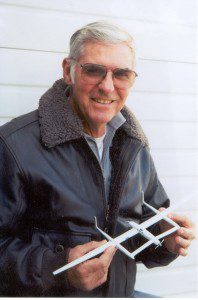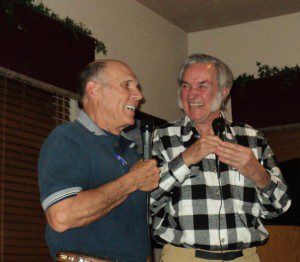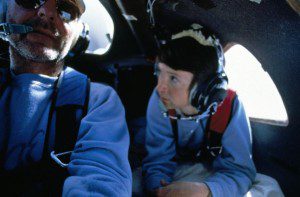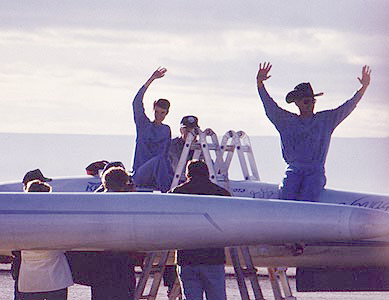[ad_1]
There are so many important aviation dates to remember in December. The Wright Brothers’ first powered flight took place on December 17, 1903, SpaceShipOne’s first glide was on December 17, 2003, on the 100th anniversary of the historic Wright Brothers flight; and Voyager’s flight between December 14 and 23, 1986.
Mojave Transportation Museum’s monthly Plane Crazy Saturday event will honor designer Burt Rutan; Command pilot, Dick Rutan; Pilot Jeana Yeager and Voyager Crew Chief Bruce Evans on December 18, 2021 at Mojave Air and Space Port. Visit www.mojavemuseum.org for more information.
Voyager’s epic flight was a milestone in aerospace history and a testament to the American spirit. Voyager’s flight, starring command pilot Dick Rutan and pilot Jeana Yeager, was the first-ever non-stop, zero-refueling flight across the world. This landmark flight lasted 9 days, 3 minutes and 44 seconds. The absolute world distance records set during this flight remain undisputed today. To date, no aircraft has flown more air miles than Voyager’s 26,358 statute miles.
In 2017, on the 31st anniversary of Voyager flight, Dick Rutan spoke on Plane Crazy Saturday at Mojave Air & Spaceport. “The flight was based on the winds and the weather, which is really upside down for all of you who fly,†Rutan said. “Normally you set your course first, but we couldn’t. The Voyager had a feather-light composite structure with thin skin and even in very slight turbulence the wings flexed and bent. We had meteorologists in the Voyage Command trailer monitoring the storms and the weather for us.
The fragile experimental aircraft weighed 939 pounds and carried over 7,000 pounds of fuel in its seventeen fuel tanks for the historic nonstop flight around the world. Its gross take-off weight for the world flight was 9,694.5 pounds, including 7,011 pounds of fuel. At the end of the flight nine days, 3 minutes and 44 seconds later, only 140 pounds of fuel remained.
“Voyager One, this is Edwards Tower. ATC clears Voyager One from Edwards Air Force Base to Edwards Air Force Base via the flight plan route. Maintain 8,000 feet. Cleared for take off and Godspeed.

The take-off on December 14 was almost catastrophic, as the wings bent and the wing tips dragged on the 15,000-foot runway. The wing tips were badly damaged. Mike, Sally Melvill and Burt Rutan were flying in a nearby Duchess plane and Mike informed Dick that he would have to get rid of the damaged winglets.
Dick applied the right rudder to cause the plane to skid in an attempt to free the fin. After trying a second time, the vane flew off and the left vane detached shortly after. There was concern that the wing pullout could damage the wing fuel cells, but it did not.
The second day, December 16, was spent dodging Typhoon Marge and the storm bands between Wake Island and the Marshal Islands. They pushed their way through a weather wall and actually caught a tailwind.
On the fourth day, they were halfway across the world over Sri Lanka. When the Voyager crew called air traffic control (ATC), they asked the routine questions, what type of aircraft, point of origin and destination. Rutan replied that the type aircraft was Voyager, the original flight KEDW (Edwards) and the destination KEDW (Edwards). ATC did not believe they were on a worldwide flight and berated the pilots for such a story. After this experience, Rutan requested that all ATC communications be handled by the people on the Voyager command trailer in Mojave. “Our phone bill was very high with all long distance phone calls,†Rutan noted.
Later that day, Voyager broke the absolute world distance record of 12,532 statute miles set by a B-52 in 1962.
Dick remembered looking down and seeing a long, beautiful runway and remembering thinking, oh how nice it would be to land and sleep. But he heard a voice in his head saying, “If you can dream it, you can do it.” The only way to fail is to quit! The voice was that of her mother, Irene Rutan. He said, “I knew we had to keep going. “

During this landmark flight, they sailed through terrible weather conditions and thunderstorms, dodged hostile countries that threatened to bring them down, feared they had enough fuel, and most of the time only ran one of the two. engines to save fuel and suffered from sleep deprivation.
After solving various mechanical issues, this intrepid team was on the final leg of the flight, flying near the tip of the Baja Peninsula at night, transferring fuel when the electric transfer pump failed. The rear engine coughed and stopped rotating due to an air bubble in the line. Exhausted, the two pilots faced yet another life-threatening issue. The rear propeller was spinning like a reel and creating drag, but the reel was the only way to start this engine if it could get the fuel flowing again.
The calm voice of Mike Melvill from Mojave encouraged Rutan to start the front engine, the only engine with a starter. When they were only 3,500 feet above the water the front engine came on and as they stabilized fuel had leaked to the rear engine and it was spinning. Also. They tilted the engine forward as much as possible but let it run. There were concerns about using more fuel, but fear and tribulation turned to joy as they passed near San Diego, and airliner pilots began sending them radio messages of congratulations.
Just south of Los Angeles, Burt Rutan and the Duchess’s Melvills met Voyager. As they entered the airspace over the Antelope Valley, Rutan called Edwards Tower and was shocked to learn that the Air Force had canceled all operations pending their return. “I couldn’t believe they would cancel all flight operations for us little ‘house builders’ in Mojave,†Rutan said.

On December 23, 1986, at 7:32 a.m., Voyager entered the limit of restricted airspace and saw the dry lake where they would land. They flew over the thousands of people who came to witness the landing, making several circuits in the sky with fighter planes before landing at 8:05 am.
The awe-inspiring flight around the world marked Voyager’s 69th flight and led Dick Rutan and Jeana Yeager into aviation history forever. The absolute world distance records set during this flight remain undisputed today. The flight was sanctioned by the FAI (Fédération Aéronautique Internationale).
Four days after landing, President Ronald Reagan presented the Voyager crew and its designer with the Presidential Medal of Citizenship. Awarded only 16 times before in history.
For their record-breaking flight, the pilots, Dick Rutan and Jeana Yeager, designer, Burt Rutan, and crew chief, Bruce Evans, won the Collier Trophy in 1986, aviation’s most prestigious award.
[ad_2]

